The Complexities of Australia's Aging Workforce: A Wicked Problem
VerifiedAdded on 2023/06/08
|9
|2917
|226
Essay
AI Summary
This essay examines the issue of the aging workforce in Australia, framing it as a 'wicked problem' due to its complexity and the lack of straightforward solutions. It highlights the increasing workforce participation rate of older Australians driven by factors like improved health, service sector job growth, and supportive tax policies. The essay explores the challenges this trend poses, including pressure on the employability of younger generations, potential impacts on innovation, and the need for sustainable business practices. It discusses the three pillars of sustainability—environmental, social, and economic—in relation to the aging workforce, considering perspectives on multigenerational workplaces and the utilization of talent. The essay argues that current approaches are failing due to underinvestment in training for new employees and the attractiveness of flexible work arrangements for older workers. It proposes the application of system thinking to better manage and utilize the talents of the aging workforce, emphasizing the importance of understanding generational differences, workforce forecasting, and customized training programs to facilitate a smooth transition to retirement.
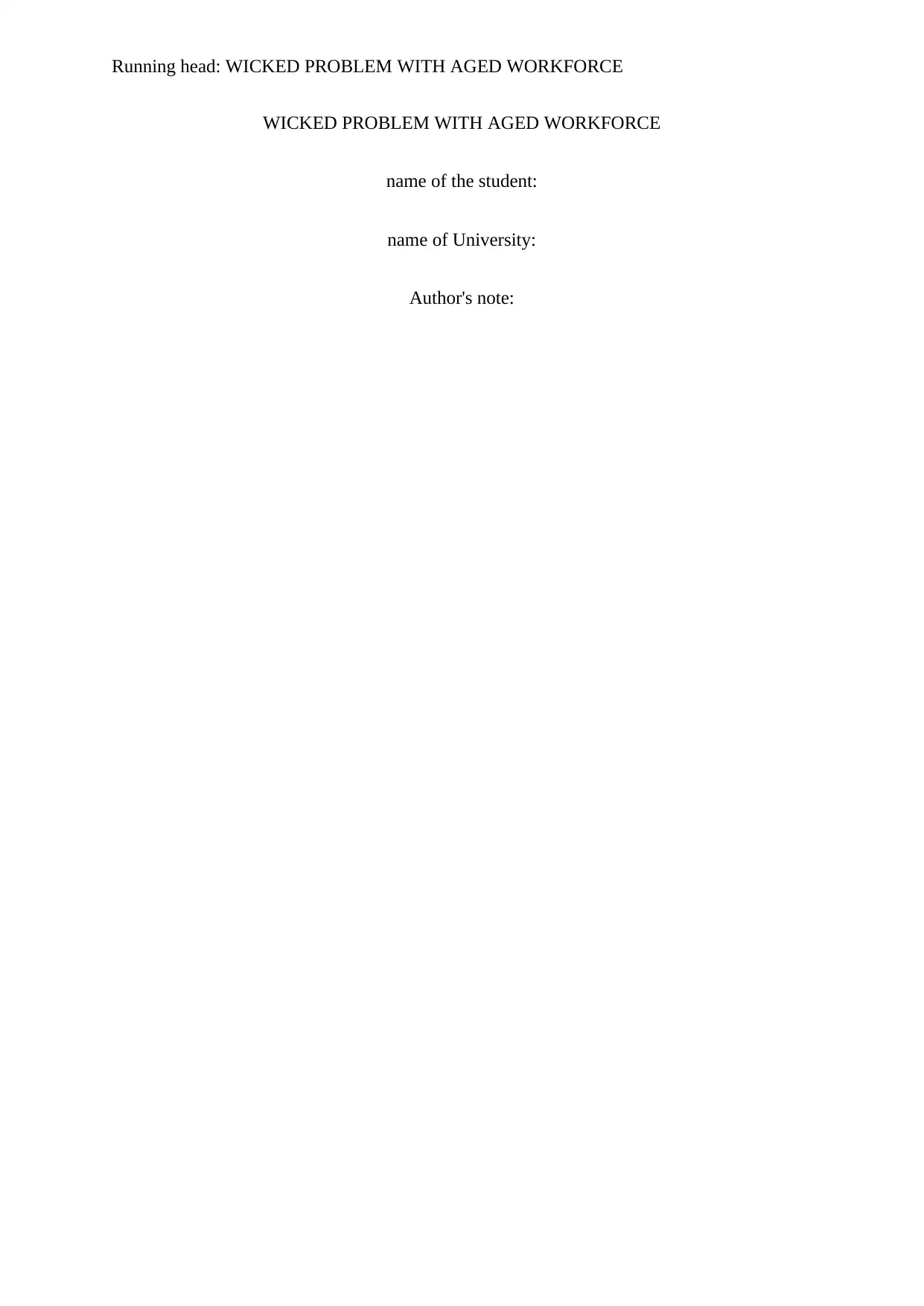
Running head: WICKED PROBLEM WITH AGED WORKFORCE
WICKED PROBLEM WITH AGED WORKFORCE
name of the student:
name of University:
Author's note:
WICKED PROBLEM WITH AGED WORKFORCE
name of the student:
name of University:
Author's note:
Paraphrase This Document
Need a fresh take? Get an instant paraphrase of this document with our AI Paraphraser
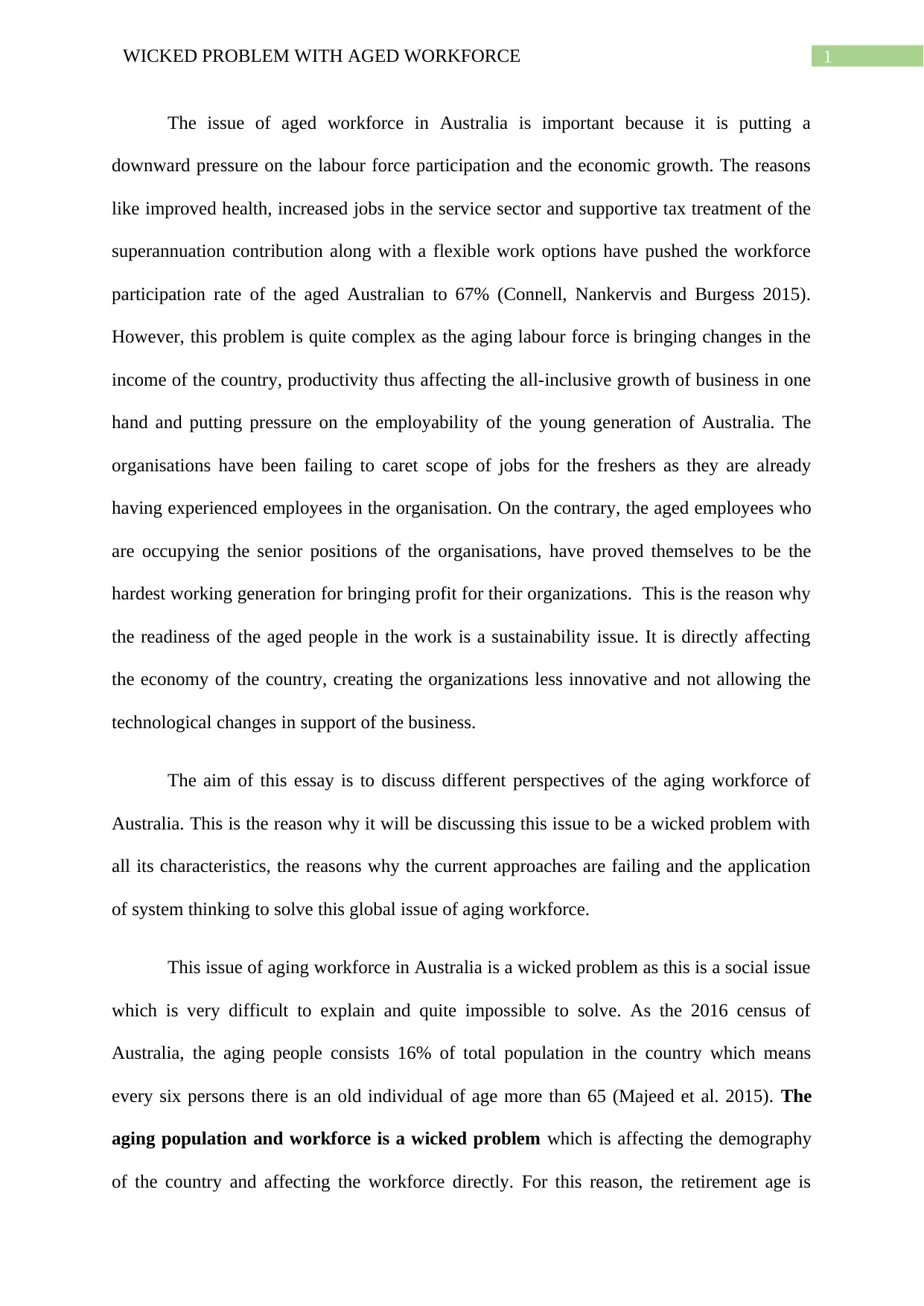
1WICKED PROBLEM WITH AGED WORKFORCE
The issue of aged workforce in Australia is important because it is putting a
downward pressure on the labour force participation and the economic growth. The reasons
like improved health, increased jobs in the service sector and supportive tax treatment of the
superannuation contribution along with a flexible work options have pushed the workforce
participation rate of the aged Australian to 67% (Connell, Nankervis and Burgess 2015).
However, this problem is quite complex as the aging labour force is bringing changes in the
income of the country, productivity thus affecting the all-inclusive growth of business in one
hand and putting pressure on the employability of the young generation of Australia. The
organisations have been failing to caret scope of jobs for the freshers as they are already
having experienced employees in the organisation. On the contrary, the aged employees who
are occupying the senior positions of the organisations, have proved themselves to be the
hardest working generation for bringing profit for their organizations. This is the reason why
the readiness of the aged people in the work is a sustainability issue. It is directly affecting
the economy of the country, creating the organizations less innovative and not allowing the
technological changes in support of the business.
The aim of this essay is to discuss different perspectives of the aging workforce of
Australia. This is the reason why it will be discussing this issue to be a wicked problem with
all its characteristics, the reasons why the current approaches are failing and the application
of system thinking to solve this global issue of aging workforce.
This issue of aging workforce in Australia is a wicked problem as this is a social issue
which is very difficult to explain and quite impossible to solve. As the 2016 census of
Australia, the aging people consists 16% of total population in the country which means
every six persons there is an old individual of age more than 65 (Majeed et al. 2015). The
aging population and workforce is a wicked problem which is affecting the demography
of the country and affecting the workforce directly. For this reason, the retirement age is
The issue of aged workforce in Australia is important because it is putting a
downward pressure on the labour force participation and the economic growth. The reasons
like improved health, increased jobs in the service sector and supportive tax treatment of the
superannuation contribution along with a flexible work options have pushed the workforce
participation rate of the aged Australian to 67% (Connell, Nankervis and Burgess 2015).
However, this problem is quite complex as the aging labour force is bringing changes in the
income of the country, productivity thus affecting the all-inclusive growth of business in one
hand and putting pressure on the employability of the young generation of Australia. The
organisations have been failing to caret scope of jobs for the freshers as they are already
having experienced employees in the organisation. On the contrary, the aged employees who
are occupying the senior positions of the organisations, have proved themselves to be the
hardest working generation for bringing profit for their organizations. This is the reason why
the readiness of the aged people in the work is a sustainability issue. It is directly affecting
the economy of the country, creating the organizations less innovative and not allowing the
technological changes in support of the business.
The aim of this essay is to discuss different perspectives of the aging workforce of
Australia. This is the reason why it will be discussing this issue to be a wicked problem with
all its characteristics, the reasons why the current approaches are failing and the application
of system thinking to solve this global issue of aging workforce.
This issue of aging workforce in Australia is a wicked problem as this is a social issue
which is very difficult to explain and quite impossible to solve. As the 2016 census of
Australia, the aging people consists 16% of total population in the country which means
every six persons there is an old individual of age more than 65 (Majeed et al. 2015). The
aging population and workforce is a wicked problem which is affecting the demography
of the country and affecting the workforce directly. For this reason, the retirement age is
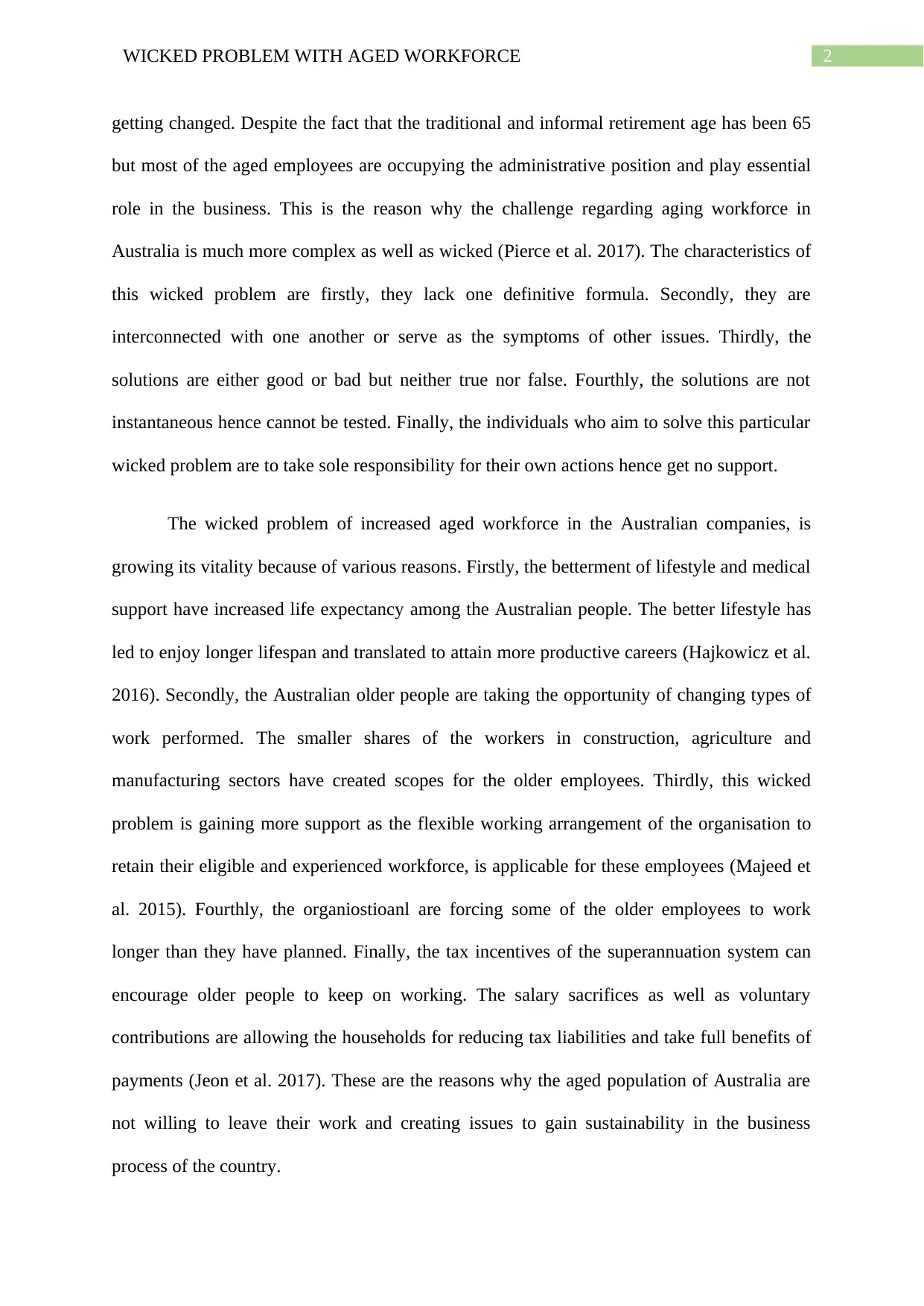
2WICKED PROBLEM WITH AGED WORKFORCE
getting changed. Despite the fact that the traditional and informal retirement age has been 65
but most of the aged employees are occupying the administrative position and play essential
role in the business. This is the reason why the challenge regarding aging workforce in
Australia is much more complex as well as wicked (Pierce et al. 2017). The characteristics of
this wicked problem are firstly, they lack one definitive formula. Secondly, they are
interconnected with one another or serve as the symptoms of other issues. Thirdly, the
solutions are either good or bad but neither true nor false. Fourthly, the solutions are not
instantaneous hence cannot be tested. Finally, the individuals who aim to solve this particular
wicked problem are to take sole responsibility for their own actions hence get no support.
The wicked problem of increased aged workforce in the Australian companies, is
growing its vitality because of various reasons. Firstly, the betterment of lifestyle and medical
support have increased life expectancy among the Australian people. The better lifestyle has
led to enjoy longer lifespan and translated to attain more productive careers (Hajkowicz et al.
2016). Secondly, the Australian older people are taking the opportunity of changing types of
work performed. The smaller shares of the workers in construction, agriculture and
manufacturing sectors have created scopes for the older employees. Thirdly, this wicked
problem is gaining more support as the flexible working arrangement of the organisation to
retain their eligible and experienced workforce, is applicable for these employees (Majeed et
al. 2015). Fourthly, the organiostioanl are forcing some of the older employees to work
longer than they have planned. Finally, the tax incentives of the superannuation system can
encourage older people to keep on working. The salary sacrifices as well as voluntary
contributions are allowing the households for reducing tax liabilities and take full benefits of
payments (Jeon et al. 2017). These are the reasons why the aged population of Australia are
not willing to leave their work and creating issues to gain sustainability in the business
process of the country.
getting changed. Despite the fact that the traditional and informal retirement age has been 65
but most of the aged employees are occupying the administrative position and play essential
role in the business. This is the reason why the challenge regarding aging workforce in
Australia is much more complex as well as wicked (Pierce et al. 2017). The characteristics of
this wicked problem are firstly, they lack one definitive formula. Secondly, they are
interconnected with one another or serve as the symptoms of other issues. Thirdly, the
solutions are either good or bad but neither true nor false. Fourthly, the solutions are not
instantaneous hence cannot be tested. Finally, the individuals who aim to solve this particular
wicked problem are to take sole responsibility for their own actions hence get no support.
The wicked problem of increased aged workforce in the Australian companies, is
growing its vitality because of various reasons. Firstly, the betterment of lifestyle and medical
support have increased life expectancy among the Australian people. The better lifestyle has
led to enjoy longer lifespan and translated to attain more productive careers (Hajkowicz et al.
2016). Secondly, the Australian older people are taking the opportunity of changing types of
work performed. The smaller shares of the workers in construction, agriculture and
manufacturing sectors have created scopes for the older employees. Thirdly, this wicked
problem is gaining more support as the flexible working arrangement of the organisation to
retain their eligible and experienced workforce, is applicable for these employees (Majeed et
al. 2015). Fourthly, the organiostioanl are forcing some of the older employees to work
longer than they have planned. Finally, the tax incentives of the superannuation system can
encourage older people to keep on working. The salary sacrifices as well as voluntary
contributions are allowing the households for reducing tax liabilities and take full benefits of
payments (Jeon et al. 2017). These are the reasons why the aged population of Australia are
not willing to leave their work and creating issues to gain sustainability in the business
process of the country.
⊘ This is a preview!⊘
Do you want full access?
Subscribe today to unlock all pages.

Trusted by 1+ million students worldwide
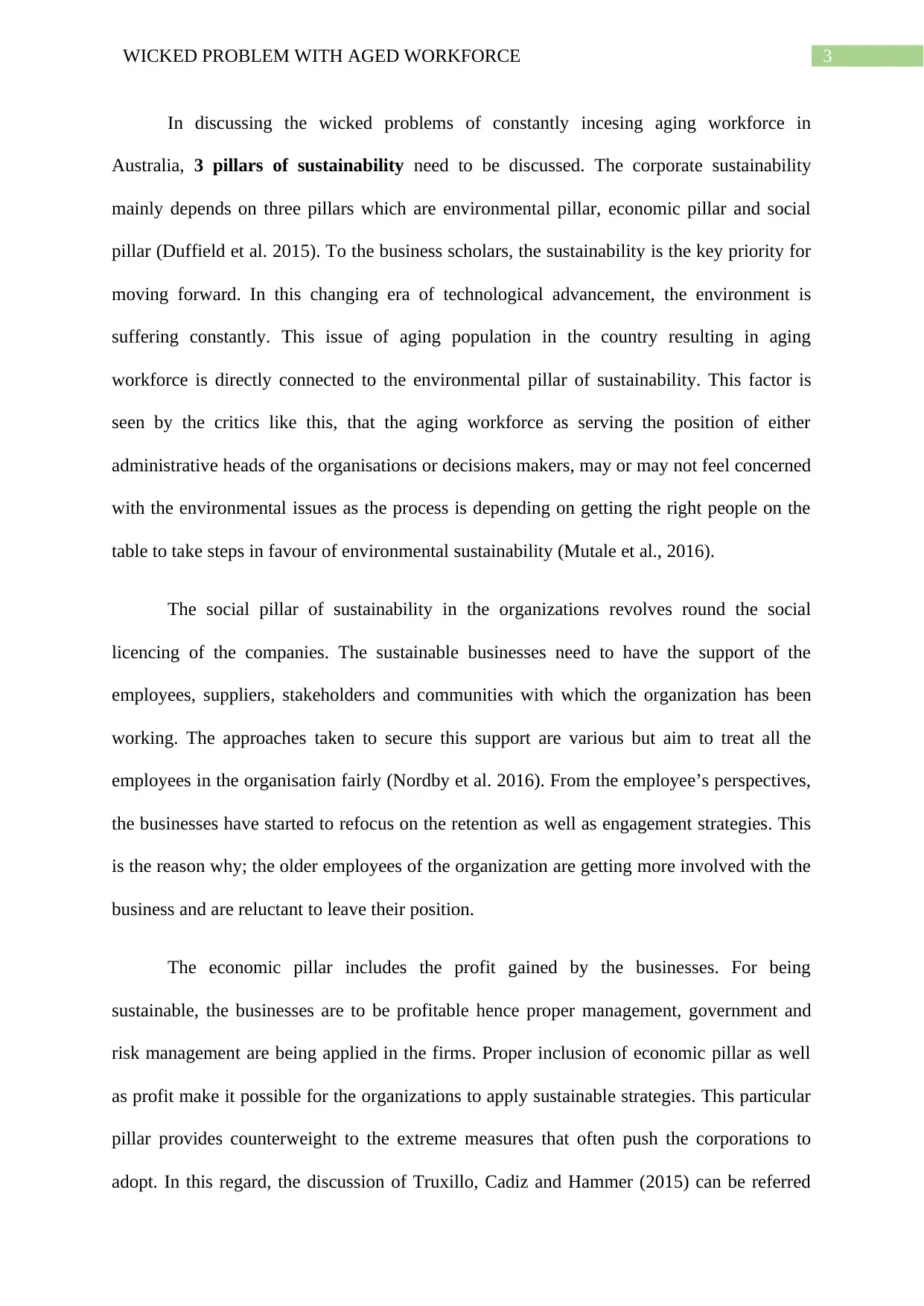
3WICKED PROBLEM WITH AGED WORKFORCE
In discussing the wicked problems of constantly incesing aging workforce in
Australia, 3 pillars of sustainability need to be discussed. The corporate sustainability
mainly depends on three pillars which are environmental pillar, economic pillar and social
pillar (Duffield et al. 2015). To the business scholars, the sustainability is the key priority for
moving forward. In this changing era of technological advancement, the environment is
suffering constantly. This issue of aging population in the country resulting in aging
workforce is directly connected to the environmental pillar of sustainability. This factor is
seen by the critics like this, that the aging workforce as serving the position of either
administrative heads of the organisations or decisions makers, may or may not feel concerned
with the environmental issues as the process is depending on getting the right people on the
table to take steps in favour of environmental sustainability (Mutale et al., 2016).
The social pillar of sustainability in the organizations revolves round the social
licencing of the companies. The sustainable businesses need to have the support of the
employees, suppliers, stakeholders and communities with which the organization has been
working. The approaches taken to secure this support are various but aim to treat all the
employees in the organisation fairly (Nordby et al. 2016). From the employee’s perspectives,
the businesses have started to refocus on the retention as well as engagement strategies. This
is the reason why; the older employees of the organization are getting more involved with the
business and are reluctant to leave their position.
The economic pillar includes the profit gained by the businesses. For being
sustainable, the businesses are to be profitable hence proper management, government and
risk management are being applied in the firms. Proper inclusion of economic pillar as well
as profit make it possible for the organizations to apply sustainable strategies. This particular
pillar provides counterweight to the extreme measures that often push the corporations to
adopt. In this regard, the discussion of Truxillo, Cadiz and Hammer (2015) can be referred
In discussing the wicked problems of constantly incesing aging workforce in
Australia, 3 pillars of sustainability need to be discussed. The corporate sustainability
mainly depends on three pillars which are environmental pillar, economic pillar and social
pillar (Duffield et al. 2015). To the business scholars, the sustainability is the key priority for
moving forward. In this changing era of technological advancement, the environment is
suffering constantly. This issue of aging population in the country resulting in aging
workforce is directly connected to the environmental pillar of sustainability. This factor is
seen by the critics like this, that the aging workforce as serving the position of either
administrative heads of the organisations or decisions makers, may or may not feel concerned
with the environmental issues as the process is depending on getting the right people on the
table to take steps in favour of environmental sustainability (Mutale et al., 2016).
The social pillar of sustainability in the organizations revolves round the social
licencing of the companies. The sustainable businesses need to have the support of the
employees, suppliers, stakeholders and communities with which the organization has been
working. The approaches taken to secure this support are various but aim to treat all the
employees in the organisation fairly (Nordby et al. 2016). From the employee’s perspectives,
the businesses have started to refocus on the retention as well as engagement strategies. This
is the reason why; the older employees of the organization are getting more involved with the
business and are reluctant to leave their position.
The economic pillar includes the profit gained by the businesses. For being
sustainable, the businesses are to be profitable hence proper management, government and
risk management are being applied in the firms. Proper inclusion of economic pillar as well
as profit make it possible for the organizations to apply sustainable strategies. This particular
pillar provides counterweight to the extreme measures that often push the corporations to
adopt. In this regard, the discussion of Truxillo, Cadiz and Hammer (2015) can be referred
Paraphrase This Document
Need a fresh take? Get an instant paraphrase of this document with our AI Paraphraser
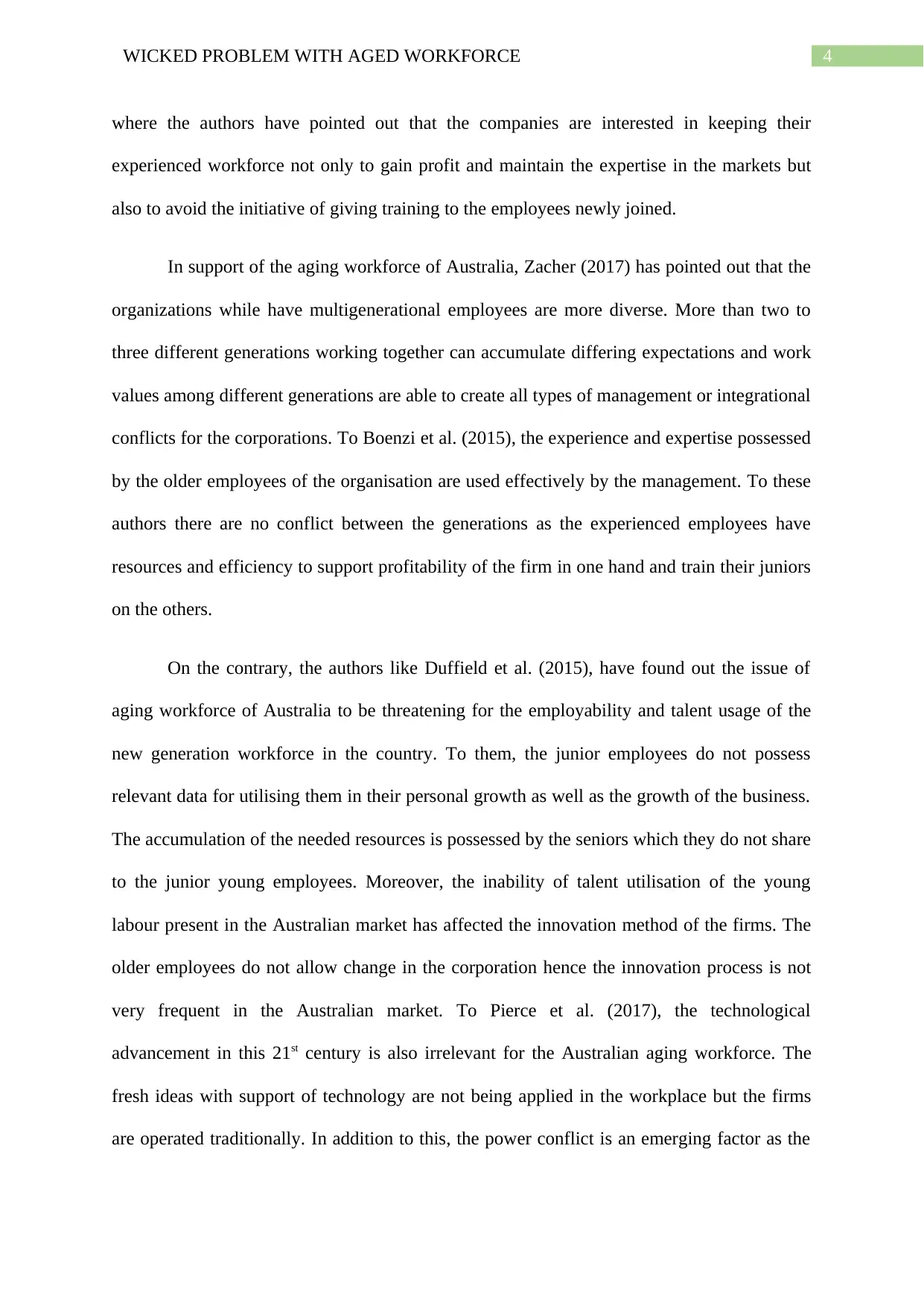
4WICKED PROBLEM WITH AGED WORKFORCE
where the authors have pointed out that the companies are interested in keeping their
experienced workforce not only to gain profit and maintain the expertise in the markets but
also to avoid the initiative of giving training to the employees newly joined.
In support of the aging workforce of Australia, Zacher (2017) has pointed out that the
organizations while have multigenerational employees are more diverse. More than two to
three different generations working together can accumulate differing expectations and work
values among different generations are able to create all types of management or integrational
conflicts for the corporations. To Boenzi et al. (2015), the experience and expertise possessed
by the older employees of the organisation are used effectively by the management. To these
authors there are no conflict between the generations as the experienced employees have
resources and efficiency to support profitability of the firm in one hand and train their juniors
on the others.
On the contrary, the authors like Duffield et al. (2015), have found out the issue of
aging workforce of Australia to be threatening for the employability and talent usage of the
new generation workforce in the country. To them, the junior employees do not possess
relevant data for utilising them in their personal growth as well as the growth of the business.
The accumulation of the needed resources is possessed by the seniors which they do not share
to the junior young employees. Moreover, the inability of talent utilisation of the young
labour present in the Australian market has affected the innovation method of the firms. The
older employees do not allow change in the corporation hence the innovation process is not
very frequent in the Australian market. To Pierce et al. (2017), the technological
advancement in this 21st century is also irrelevant for the Australian aging workforce. The
fresh ideas with support of technology are not being applied in the workplace but the firms
are operated traditionally. In addition to this, the power conflict is an emerging factor as the
where the authors have pointed out that the companies are interested in keeping their
experienced workforce not only to gain profit and maintain the expertise in the markets but
also to avoid the initiative of giving training to the employees newly joined.
In support of the aging workforce of Australia, Zacher (2017) has pointed out that the
organizations while have multigenerational employees are more diverse. More than two to
three different generations working together can accumulate differing expectations and work
values among different generations are able to create all types of management or integrational
conflicts for the corporations. To Boenzi et al. (2015), the experience and expertise possessed
by the older employees of the organisation are used effectively by the management. To these
authors there are no conflict between the generations as the experienced employees have
resources and efficiency to support profitability of the firm in one hand and train their juniors
on the others.
On the contrary, the authors like Duffield et al. (2015), have found out the issue of
aging workforce of Australia to be threatening for the employability and talent usage of the
new generation workforce in the country. To them, the junior employees do not possess
relevant data for utilising them in their personal growth as well as the growth of the business.
The accumulation of the needed resources is possessed by the seniors which they do not share
to the junior young employees. Moreover, the inability of talent utilisation of the young
labour present in the Australian market has affected the innovation method of the firms. The
older employees do not allow change in the corporation hence the innovation process is not
very frequent in the Australian market. To Pierce et al. (2017), the technological
advancement in this 21st century is also irrelevant for the Australian aging workforce. The
fresh ideas with support of technology are not being applied in the workplace but the firms
are operated traditionally. In addition to this, the power conflict is an emerging factor as the
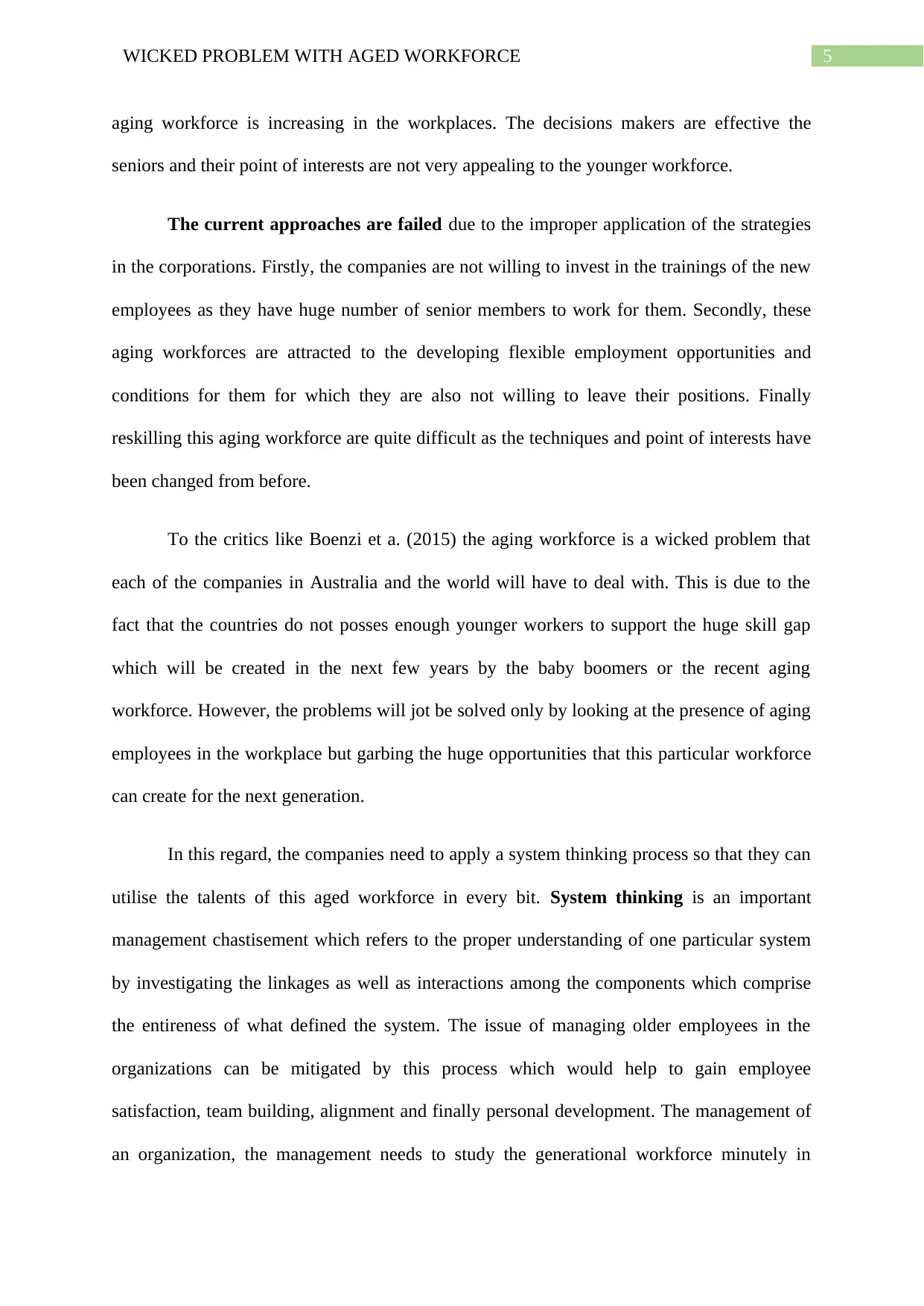
5WICKED PROBLEM WITH AGED WORKFORCE
aging workforce is increasing in the workplaces. The decisions makers are effective the
seniors and their point of interests are not very appealing to the younger workforce.
The current approaches are failed due to the improper application of the strategies
in the corporations. Firstly, the companies are not willing to invest in the trainings of the new
employees as they have huge number of senior members to work for them. Secondly, these
aging workforces are attracted to the developing flexible employment opportunities and
conditions for them for which they are also not willing to leave their positions. Finally
reskilling this aging workforce are quite difficult as the techniques and point of interests have
been changed from before.
To the critics like Boenzi et a. (2015) the aging workforce is a wicked problem that
each of the companies in Australia and the world will have to deal with. This is due to the
fact that the countries do not posses enough younger workers to support the huge skill gap
which will be created in the next few years by the baby boomers or the recent aging
workforce. However, the problems will jot be solved only by looking at the presence of aging
employees in the workplace but garbing the huge opportunities that this particular workforce
can create for the next generation.
In this regard, the companies need to apply a system thinking process so that they can
utilise the talents of this aged workforce in every bit. System thinking is an important
management chastisement which refers to the proper understanding of one particular system
by investigating the linkages as well as interactions among the components which comprise
the entireness of what defined the system. The issue of managing older employees in the
organizations can be mitigated by this process which would help to gain employee
satisfaction, team building, alignment and finally personal development. The management of
an organization, the management needs to study the generational workforce minutely in
aging workforce is increasing in the workplaces. The decisions makers are effective the
seniors and their point of interests are not very appealing to the younger workforce.
The current approaches are failed due to the improper application of the strategies
in the corporations. Firstly, the companies are not willing to invest in the trainings of the new
employees as they have huge number of senior members to work for them. Secondly, these
aging workforces are attracted to the developing flexible employment opportunities and
conditions for them for which they are also not willing to leave their positions. Finally
reskilling this aging workforce are quite difficult as the techniques and point of interests have
been changed from before.
To the critics like Boenzi et a. (2015) the aging workforce is a wicked problem that
each of the companies in Australia and the world will have to deal with. This is due to the
fact that the countries do not posses enough younger workers to support the huge skill gap
which will be created in the next few years by the baby boomers or the recent aging
workforce. However, the problems will jot be solved only by looking at the presence of aging
employees in the workplace but garbing the huge opportunities that this particular workforce
can create for the next generation.
In this regard, the companies need to apply a system thinking process so that they can
utilise the talents of this aged workforce in every bit. System thinking is an important
management chastisement which refers to the proper understanding of one particular system
by investigating the linkages as well as interactions among the components which comprise
the entireness of what defined the system. The issue of managing older employees in the
organizations can be mitigated by this process which would help to gain employee
satisfaction, team building, alignment and finally personal development. The management of
an organization, the management needs to study the generational workforce minutely in
⊘ This is a preview!⊘
Do you want full access?
Subscribe today to unlock all pages.

Trusted by 1+ million students worldwide
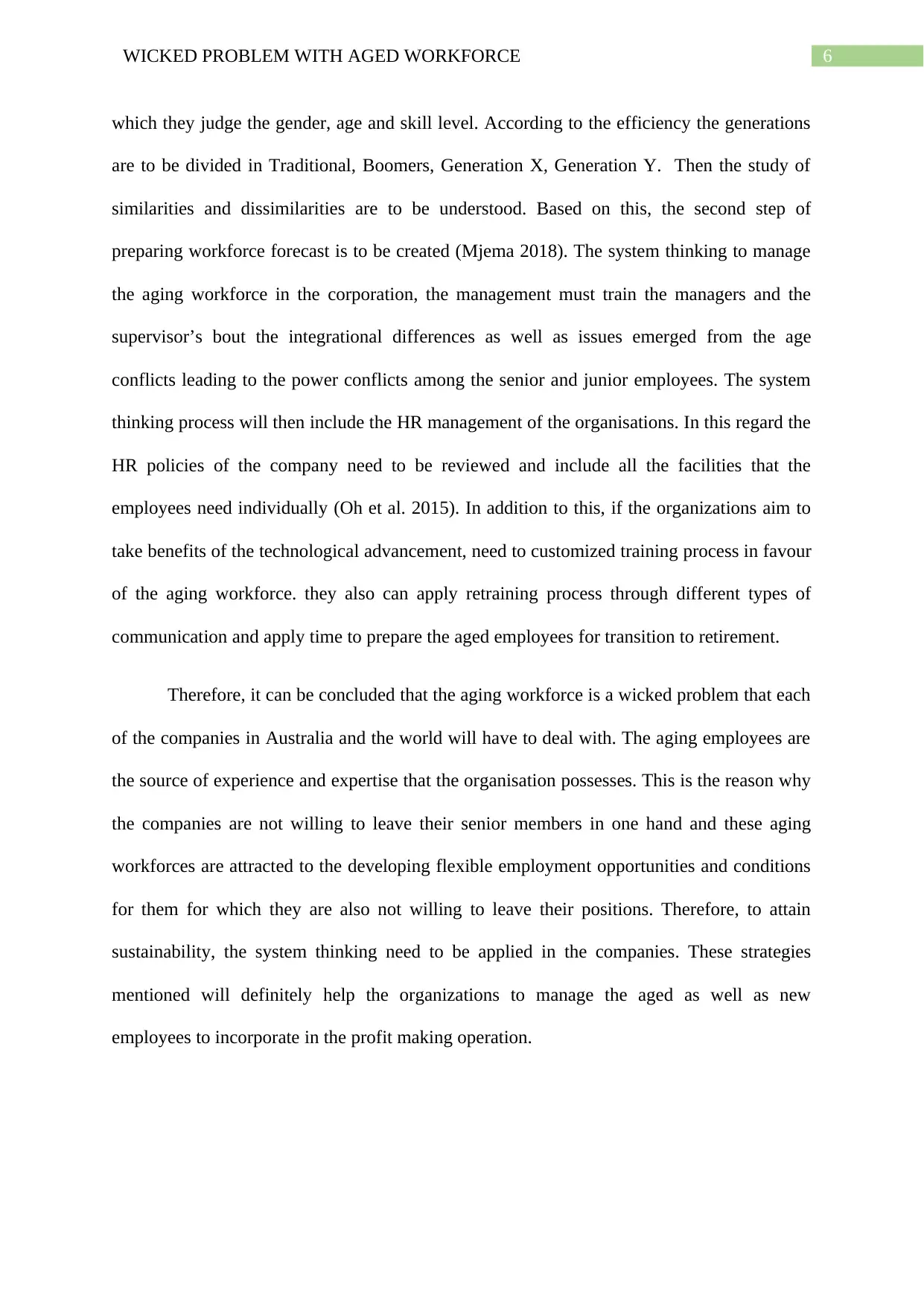
6WICKED PROBLEM WITH AGED WORKFORCE
which they judge the gender, age and skill level. According to the efficiency the generations
are to be divided in Traditional, Boomers, Generation X, Generation Y. Then the study of
similarities and dissimilarities are to be understood. Based on this, the second step of
preparing workforce forecast is to be created (Mjema 2018). The system thinking to manage
the aging workforce in the corporation, the management must train the managers and the
supervisor’s bout the integrational differences as well as issues emerged from the age
conflicts leading to the power conflicts among the senior and junior employees. The system
thinking process will then include the HR management of the organisations. In this regard the
HR policies of the company need to be reviewed and include all the facilities that the
employees need individually (Oh et al. 2015). In addition to this, if the organizations aim to
take benefits of the technological advancement, need to customized training process in favour
of the aging workforce. they also can apply retraining process through different types of
communication and apply time to prepare the aged employees for transition to retirement.
Therefore, it can be concluded that the aging workforce is a wicked problem that each
of the companies in Australia and the world will have to deal with. The aging employees are
the source of experience and expertise that the organisation possesses. This is the reason why
the companies are not willing to leave their senior members in one hand and these aging
workforces are attracted to the developing flexible employment opportunities and conditions
for them for which they are also not willing to leave their positions. Therefore, to attain
sustainability, the system thinking need to be applied in the companies. These strategies
mentioned will definitely help the organizations to manage the aged as well as new
employees to incorporate in the profit making operation.
which they judge the gender, age and skill level. According to the efficiency the generations
are to be divided in Traditional, Boomers, Generation X, Generation Y. Then the study of
similarities and dissimilarities are to be understood. Based on this, the second step of
preparing workforce forecast is to be created (Mjema 2018). The system thinking to manage
the aging workforce in the corporation, the management must train the managers and the
supervisor’s bout the integrational differences as well as issues emerged from the age
conflicts leading to the power conflicts among the senior and junior employees. The system
thinking process will then include the HR management of the organisations. In this regard the
HR policies of the company need to be reviewed and include all the facilities that the
employees need individually (Oh et al. 2015). In addition to this, if the organizations aim to
take benefits of the technological advancement, need to customized training process in favour
of the aging workforce. they also can apply retraining process through different types of
communication and apply time to prepare the aged employees for transition to retirement.
Therefore, it can be concluded that the aging workforce is a wicked problem that each
of the companies in Australia and the world will have to deal with. The aging employees are
the source of experience and expertise that the organisation possesses. This is the reason why
the companies are not willing to leave their senior members in one hand and these aging
workforces are attracted to the developing flexible employment opportunities and conditions
for them for which they are also not willing to leave their positions. Therefore, to attain
sustainability, the system thinking need to be applied in the companies. These strategies
mentioned will definitely help the organizations to manage the aged as well as new
employees to incorporate in the profit making operation.
Paraphrase This Document
Need a fresh take? Get an instant paraphrase of this document with our AI Paraphraser
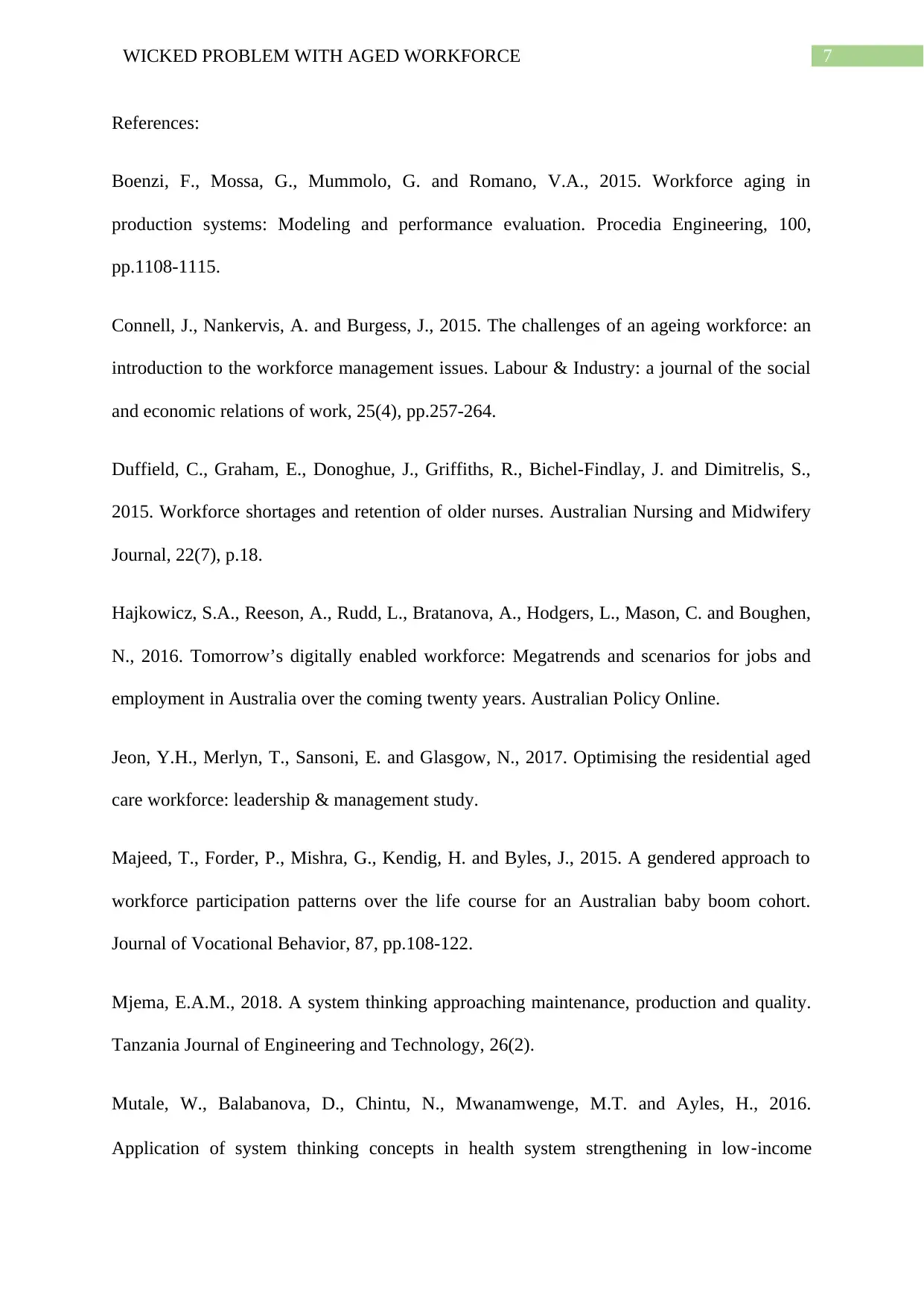
7WICKED PROBLEM WITH AGED WORKFORCE
References:
Boenzi, F., Mossa, G., Mummolo, G. and Romano, V.A., 2015. Workforce aging in
production systems: Modeling and performance evaluation. Procedia Engineering, 100,
pp.1108-1115.
Connell, J., Nankervis, A. and Burgess, J., 2015. The challenges of an ageing workforce: an
introduction to the workforce management issues. Labour & Industry: a journal of the social
and economic relations of work, 25(4), pp.257-264.
Duffield, C., Graham, E., Donoghue, J., Griffiths, R., Bichel-Findlay, J. and Dimitrelis, S.,
2015. Workforce shortages and retention of older nurses. Australian Nursing and Midwifery
Journal, 22(7), p.18.
Hajkowicz, S.A., Reeson, A., Rudd, L., Bratanova, A., Hodgers, L., Mason, C. and Boughen,
N., 2016. Tomorrow’s digitally enabled workforce: Megatrends and scenarios for jobs and
employment in Australia over the coming twenty years. Australian Policy Online.
Jeon, Y.H., Merlyn, T., Sansoni, E. and Glasgow, N., 2017. Optimising the residential aged
care workforce: leadership & management study.
Majeed, T., Forder, P., Mishra, G., Kendig, H. and Byles, J., 2015. A gendered approach to
workforce participation patterns over the life course for an Australian baby boom cohort.
Journal of Vocational Behavior, 87, pp.108-122.
Mjema, E.A.M., 2018. A system thinking approaching maintenance, production and quality.
Tanzania Journal of Engineering and Technology, 26(2).
Mutale, W., Balabanova, D., Chintu, N., Mwanamwenge, M.T. and Ayles, H., 2016.
Application of system thinking concepts in health system strengthening in low‐income
References:
Boenzi, F., Mossa, G., Mummolo, G. and Romano, V.A., 2015. Workforce aging in
production systems: Modeling and performance evaluation. Procedia Engineering, 100,
pp.1108-1115.
Connell, J., Nankervis, A. and Burgess, J., 2015. The challenges of an ageing workforce: an
introduction to the workforce management issues. Labour & Industry: a journal of the social
and economic relations of work, 25(4), pp.257-264.
Duffield, C., Graham, E., Donoghue, J., Griffiths, R., Bichel-Findlay, J. and Dimitrelis, S.,
2015. Workforce shortages and retention of older nurses. Australian Nursing and Midwifery
Journal, 22(7), p.18.
Hajkowicz, S.A., Reeson, A., Rudd, L., Bratanova, A., Hodgers, L., Mason, C. and Boughen,
N., 2016. Tomorrow’s digitally enabled workforce: Megatrends and scenarios for jobs and
employment in Australia over the coming twenty years. Australian Policy Online.
Jeon, Y.H., Merlyn, T., Sansoni, E. and Glasgow, N., 2017. Optimising the residential aged
care workforce: leadership & management study.
Majeed, T., Forder, P., Mishra, G., Kendig, H. and Byles, J., 2015. A gendered approach to
workforce participation patterns over the life course for an Australian baby boom cohort.
Journal of Vocational Behavior, 87, pp.108-122.
Mjema, E.A.M., 2018. A system thinking approaching maintenance, production and quality.
Tanzania Journal of Engineering and Technology, 26(2).
Mutale, W., Balabanova, D., Chintu, N., Mwanamwenge, M.T. and Ayles, H., 2016.
Application of system thinking concepts in health system strengthening in low‐income
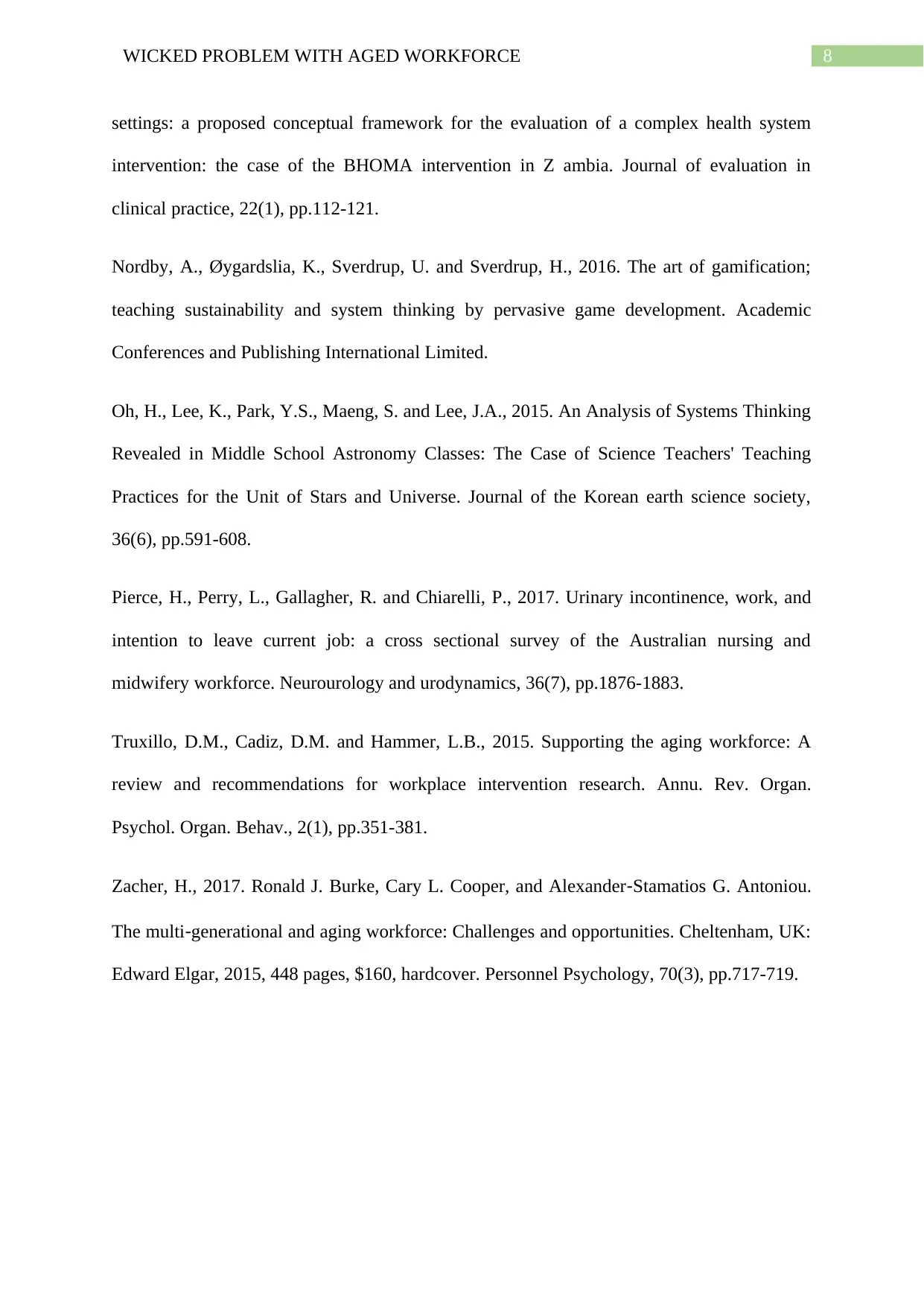
8WICKED PROBLEM WITH AGED WORKFORCE
settings: a proposed conceptual framework for the evaluation of a complex health system
intervention: the case of the BHOMA intervention in Z ambia. Journal of evaluation in
clinical practice, 22(1), pp.112-121.
Nordby, A., Øygardslia, K., Sverdrup, U. and Sverdrup, H., 2016. The art of gamification;
teaching sustainability and system thinking by pervasive game development. Academic
Conferences and Publishing International Limited.
Oh, H., Lee, K., Park, Y.S., Maeng, S. and Lee, J.A., 2015. An Analysis of Systems Thinking
Revealed in Middle School Astronomy Classes: The Case of Science Teachers' Teaching
Practices for the Unit of Stars and Universe. Journal of the Korean earth science society,
36(6), pp.591-608.
Pierce, H., Perry, L., Gallagher, R. and Chiarelli, P., 2017. Urinary incontinence, work, and
intention to leave current job: a cross sectional survey of the Australian nursing and
midwifery workforce. Neurourology and urodynamics, 36(7), pp.1876-1883.
Truxillo, D.M., Cadiz, D.M. and Hammer, L.B., 2015. Supporting the aging workforce: A
review and recommendations for workplace intervention research. Annu. Rev. Organ.
Psychol. Organ. Behav., 2(1), pp.351-381.
Zacher, H., 2017. Ronald J. Burke, Cary L. Cooper, and Alexander‐Stamatios G. Antoniou.
The multi‐generational and aging workforce: Challenges and opportunities. Cheltenham, UK:
Edward Elgar, 2015, 448 pages, $160, hardcover. Personnel Psychology, 70(3), pp.717-719.
settings: a proposed conceptual framework for the evaluation of a complex health system
intervention: the case of the BHOMA intervention in Z ambia. Journal of evaluation in
clinical practice, 22(1), pp.112-121.
Nordby, A., Øygardslia, K., Sverdrup, U. and Sverdrup, H., 2016. The art of gamification;
teaching sustainability and system thinking by pervasive game development. Academic
Conferences and Publishing International Limited.
Oh, H., Lee, K., Park, Y.S., Maeng, S. and Lee, J.A., 2015. An Analysis of Systems Thinking
Revealed in Middle School Astronomy Classes: The Case of Science Teachers' Teaching
Practices for the Unit of Stars and Universe. Journal of the Korean earth science society,
36(6), pp.591-608.
Pierce, H., Perry, L., Gallagher, R. and Chiarelli, P., 2017. Urinary incontinence, work, and
intention to leave current job: a cross sectional survey of the Australian nursing and
midwifery workforce. Neurourology and urodynamics, 36(7), pp.1876-1883.
Truxillo, D.M., Cadiz, D.M. and Hammer, L.B., 2015. Supporting the aging workforce: A
review and recommendations for workplace intervention research. Annu. Rev. Organ.
Psychol. Organ. Behav., 2(1), pp.351-381.
Zacher, H., 2017. Ronald J. Burke, Cary L. Cooper, and Alexander‐Stamatios G. Antoniou.
The multi‐generational and aging workforce: Challenges and opportunities. Cheltenham, UK:
Edward Elgar, 2015, 448 pages, $160, hardcover. Personnel Psychology, 70(3), pp.717-719.
⊘ This is a preview!⊘
Do you want full access?
Subscribe today to unlock all pages.

Trusted by 1+ million students worldwide
1 out of 9
Related Documents
Your All-in-One AI-Powered Toolkit for Academic Success.
+13062052269
info@desklib.com
Available 24*7 on WhatsApp / Email
![[object Object]](/_next/static/media/star-bottom.7253800d.svg)
Unlock your academic potential
Copyright © 2020–2025 A2Z Services. All Rights Reserved. Developed and managed by ZUCOL.



